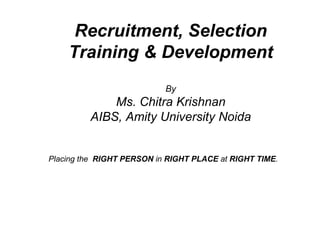
RSTD
- 1. Recruitment, Selection Training & Development By Ms. Chitra Krishnan AIBS, Amity University Noida Placing the RIGHT PERSON in RIGHT PLACE at RIGHT TIME .
- 8. Sources of Recruitment SOURCES OF RECRUITMENT
- 11. Selection
- 12. Definition Personnel Selection is the methodical placement of individuals into jobs. Its impact on the organization is realized when employees achieve years or decades of service to the employer. The process of selection follows a methodology to collect information about an individual in order to determine if that individual should be employed. The methodology used should not violate any laws regarding personnel selection.
- 15. The process of personnel selection involves collecting information about individuals for the purpose of determining suitability for employment in a particular job. This Information is collected using one or more selection devices or methods which are categorized below: interviews personality tests biographical data cognitive ability tests work sample tests physical abilities tests self assessments assessment centers
- 19. Comprehensive Structured Interviews Candidates are asked questions pertaining to how they would handle job-related situations, job knowledge, worker requirements, and how the candidate would perform various job simulations. Interviews tapping job knowledge offer a way to assess a candidate's current level of knowledge related to relevant implicit dimensions of job performance (i.e., "tacit knowledge" or "practical intelligence" related to a specific job position) Structured Behavioral Interview This technique involves asking all interviewees standardized questions about how they handled past situations that were similar to situations they may encounter on the job. The interviewer may also ask discretionary probing questions for details of the situations, the interviewee's behavior in the situation and the outcome. The interviewee's responses are then scored with behaviorally anchored rating scales. Oral Interview Boards This technique entails the job candidate giving oral responses to job-related questions asked by a panel of interviewers. Each member of the panel then rates each interviewee on such dimensions as work history, motivation, creative thinking, and presentation. The scoring procedure for oral interview boards has typically been subjective; thus, it would be subject to personal biases of those individuals sitting on the board. This technique may not be feasible for jobs in which there are a large number of applicants that must be interviewed.
- 22. Types of Personality Tests Personal Attribute Inventory. An interpersonal assessment instrument which consists of 50 positive and 50 negative adjectives from Gough's Adjective Check List. The subject is to select 30 which are most descriptive of the target group or person in question. This instrument was specifically designed to tap affective reactions and may be used in either assessing attitudes toward others or as a self-concept scale. Personality Adjective Checklist A comprehensive, objective measure of eight personality styles (which are closely aligned with DSM-III-R Axis II constructs). These eight personality styles are: introversive, inhibited, cooperative, sociable, confident, forceful, respectful, and sensitive. This instrument is designed for use with non psychiatric patients and normal adults who read minimally at the eighth grade level. Test reports are computer-generated and are intended for use by qualified professionals only. Interpretive statements are based on empirical data and theoretical inference. They are considered probabilistic in nature and cannot be considered definitive. (2K )
- 25. Types of Biographical Data Selection Procedures Background Information/Application Blanks Paper-and-pencil questionnaires, interviews, and communications with past employers in order to assess an individual's behavioral reliability, integrity, and personal adjustment. In order to implement this technique a validation study would have to be conducted. Empirically-keyed Biodata Applicants are presented with a list of questions pertaining to such things as one's economic stability, work ethic orientation, and educational achievement. Applicants' scores are determined by weighting each item according to the item's empirically derived relationship to the criterion of interest. This technique requires a validation study to be carried out in order to obtain the empirically derived weights for the Biodata.
- 26. Rationally-keyed Biodata Applicants are presented with a list of questions pertaining to such things as one's economic stability, work ethic orientation and educational achievement. Applicants' scores are determined by weighting each item according to the item's rationally derived relationship to the criterion of interest. Research indicates the predictive validity of this technique may be lower than other available techniques with no evidence for reduced adverse impact against minorities.
- 34. ROLE OF TRAINING
- 39. The training consultancies offer various benefits such as:
- 70. Procedure of Sensitivity Training
- 74. Training-Design